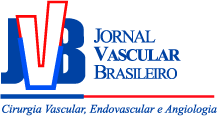Técnica para quantificação e qualificação de material coletado em filtros de proteção cerebral
Gabriel Santos Novaes; Álvaro Razuk Filho; Geanete Pozzan; Andrea Reis; Alexandre Fioranelli; Valter Castelli Jr.; Walter Khegan Karakhanian; Roberto Augusto Caffaro
Resumo
Palavras-chave
References
Barnett HJ, Taylor DW, Eliasziw M. Benefit of carotid endarterectomy in patients with symptomatic moderate or severe stenosis: North American Symptomatic Carotid Endarterectomy Trial Collaborators. N Engl J Med. 1998;339:1415-25.
Beneficial effect of carotid endarterectomy in symptomatic patients with high grade carotid stenosis: North American Symptomatic Carotid Endarterectomy Trial Collaboration. N Engl J Med. 1991;325:445-53.
MRC European Carotid Surgery Trial: Interim results for symptomatic patients with severe (70-99%) or with mild (0-29%) carotid stenosis. The European Carotid Surgery Trialists Collaborative Group. Lancet. 1991;337:1235-43.
Endarterectomy for moderate symptomatic carotid stenosis: interim results from de MRC European Carotid Surgery Trial. Lancet. 1996;347:1591-3.
Randomized trial of endarterectomy for recently symptomatic carotid stenosis: Final results of the MRC European Carotid Surgery Trial (ECST). Lancet. 1998;351:1379-87.
Sprouse LR 2nd, Peeters P, Bosiers M. The capture of visible debris by distal cerebral protection filters during carotid artery stenting: Is it predictable?. J Vasc Surg. 2005;41:950-5.
Yadav IS, Wholey MH, Kuntz RE. Protected carotid-artery stenting versus endarterectomy in high risk patients. N Engl J Med. 2004;351:1493-501.
Crawley F, Clifton A, Buckenham T, Loosemore T, Taylor RS, Brown MM. Comparison of hemodynamic cerebral ischemia and microembolic signals detected during carotid endarterectomy and carotid angioplasty. Stroke. 1997;28:2460-4.
Manninen HI, Rasanen HT, Vanninen RL, Vainio P, Hippeläinen M, Kosma VM. Stent placement versus percutaneous transluminal angioplasty of human carotid arteries in cadaver in situ: distal embolization and findings at intravascular. Radiology. 1999;212:483-92.
Parodi JC, Ferreira LM, Sicard G, La Mura R, Fernandez S. Cerebral protection during carotid stenting using flow reversal. J Vasc Surg. 2005;41:416-22.
Rapp JH, Wakil L, Sawhney RS. Subclinical embolization after carotid artery stenting: new lesions of diffusion-weighted magnetic resonance imaging occur postprocedure. J Vasc Surg. 2007;45:867-72.
Bosiers M, de Donato G, Deloose K. Does free cell area influence the outcome in carotid artery stenting?. Eur J Vasc Edovasc Surg. 2007;33:135-41.
Burton KR, Lindsay TE. Assessment of short-term outcomes for protected carotid angioplasty with stents using recent evidence. J Vasc Surg. 2005;42:1094-100.
Mellière D. Carotid surgery: assessment and current problems. J Mal Vasc. 1993;18:176-85.
Ohki T, Marin NL, Lyon RT. Ex vivo human carotid artery bifurcation stenting: Correlation of lesion characteristics with embolic potential. J Vasc Surg. 1998;27:463-71.
Theron J, Courtheoux P, Alachkar F, Bouvard G, Maiza D. New triple coaxial catheter system for carotid angioplasty with cerebral protection. Am J Neuroradiol. 1990;11:869-74.
Angelini A, Reimers B, Della Barbera M. Cerebral protection during carotid artery stenting: collection and histopathologic analysis of embolized debris. Stroke. 2002;33:456-61.
Cremonesi A, Manetti R, Setacci F, Setacci C, Castriota F. Protected carotid stent: Clinical advantages and complications of embolic protection devices in 442 consecutive patients. Stroke. 2003;34:1936-41.
Reimers B, Corvaja N, Moshiri S. Cerebral protection with filter devices during carotid artery stenting. Circulation. 2001;104:12-5.
Wholey MH, Wholey M, Mathias K. Global experience in cervical carotid artery stent placement. Catheter Cardiovasc Intervent. 2000;50:160-7.
DeRubertis BG, Chaer RA, Gordon R. Determining the quantity and character of carotid artery embolic debris by electron microscopy and energy dispersive spectroscopy. J Vasc Surg. 2007;45:716-25.
Maleux G, Demaerel P, Verbeken E. Cerebral ischemia after filter-protected carotid artery stenting is common and cannot be predicted by the presence of substantial amount of debris captured by the filter device. Am J Neuroradiol. 2006;27:1830-3.
Whitlow PL, Lylyk P, Londero H. Carotid artery stenting protected with an emboli containment system. Stroke. 2002;33:1308-14.
Müller-Hülsbeck S, Stolzmann P, Liess C. Vessel wall damage caused by cerebral protection devices: Ex vivo evaluation in porcine carotid arteries. Radiology. 2005;235:454-60.

